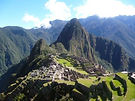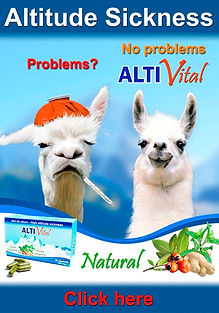PERU INFO
Home > About Peru > Economy > Agriculture
About Peru
Agriculture
Due to its complicated geographical features, the arid coast, the rugged Andes mountains and the jungle difficult to access, Peru has a rather small agricultural area with 1.7% of the territory. Comparatively USA and UK have 25%, France 53%.
Agricultural production
Agriculture has been the traditional activity of prehispanic Peru where several products of primary importance were developed and are found today all over the world.
Peru is the country of origin of the potato, tomato, quinoa, bean and cassava among others.
Export of agricultural products is now the third largest economic sector of the country ahead of textiles (cotton and alpaca) et behind the extraction of minerals and industrial fishery.
Since the 2000s, Peru is the first world exporter of asparagus with an average of 100,000 annual T (more than US$500 milion), ahead of China and Mexico.
The country is also the leading exporter of paprika with about 50,000 t per year (US$200 milion) in competition with China, as well as organic bananas with 170 milion T in 2014 (US$120 milion).
Peru is also one of the world's leading exporters of artichokes and quinoa (2nd), mangoes (3rd), citrus and avocado (5th), grapes (7th).
The agrarian reform
The Peruvian land reform, implemented in 1969 by the military government of Juan Velasco Alvarado, to ending the powerful agribusiness and large landowners and ranchers, organizing cooperatives in rural communities. In this way the campesinos who worked on the haciendas would become owners of a small parcel of land, animals and tools.
The reform produced a radical change of Peruvian agriculture, but also brought unexpected problems. The farmer associations did not achieve the required level of efficiency, most disintegrating, resulting in excessive division of land among farmers and the rapid degradation of productivity due to a lack of knowledge and technical preparation by the new farmers owners.
Potato (papa)
Solanum Tuberosum
"Papa" is the name that Incas gave this tuber, originates on the north shore of Lake Titicaca at 3,800 meters (12,500 ft) a.s.l. and its story began about 8,000 years ago.
The Incas (1200-1500 AD.) have domesticated, improved and created an infinite variety of tubers so important for food safety of the empire, like in the agricultural experiment station of Moray (near Cusco).
Today, only in Peru there are 2,321 varieties of potatoes (source: Ministry of Agriculture). The CIP (International Potato Center) founded in Lima in 1971, has a genetic bank of some 5,000 different types of cultivated and wild potatoes, 6,500 varieties of sweet potatoes and 1,300 types of other Andean roots and tubers.
Freeze-dried potato
Chuño
The process of dehydration and freezing of potatoes is traditionally practiced for over 2000 years in the Andes.
The drying method involves exposing the tubers to cycles of freezing at nights and exposition to the sun for several days, supplemented by a trampling by foot to eliminates whta little water is still retained by th potatoes. Repeated sun exposure gives it a black color.
Thus potatoes can be stored for many years.
Tunta or moraya
Unlike chuño, the tunta is not exposed to the sun. After a freezing night, potatoes are trampled by foot and then put in a river or lagoon for several days to finally be trampled again. Because they are not exposed to sunlight and with the loss of skin during trampling, the tunta retains the white color of its flesh.
Sweet potato (camote)
Ipomea Batatas
The origin of sweet potato is in South America, domesticated and cultivated 8,000 years ago in the department of Ayacucho (Peru). representations of potatoes have been found in numerous pre-Columbian ceramics and remains of tuberous roots in tombs.
The sweet potato arrived in Europe in the sixteenth century and spread throughout the world.
It is consumed in many ways, with meat and fish but also in the preparation of desserts (donuts, jams, etc.).
This root has a pleasant taste, very sweet, is very nutritious, energetic and rich in carotene and provitamin A. Of the numerous varieties in Peru are 2 main types, the yellow and the purple.
Chili pepper
Genre: Capsicum
Originated in Peru and Ecuador, chili peppers have been a part of the human diet in the South America since at least 9,000 years. Then it spread throughout tropical America thanks to bird droppings who love the chili and are insensitive to capsaicin, the substance that gives the spicy flavor.
Unlike potatoes and tomatoes that take long to be accepted as food in Europe, chili took less than 50 years to be integrated into cooking worldwide.
In Peru there are about 50 varieties of chili, more or less spicy and today Peru is the first world's producer of paprika, a variety of chili.
Tomato (tomate)
Lycopersicon Escultelum
It is a fruit belongs to the nightshade family Solanaceae, the same of potato, peppers and eggplant and is considered a vegetable for culinary use. The tomato originated in the highlands of western coast of Peru (from Ecuador to northern Chile). Investigations has demonstrated its origin in the Andes by archaeological evidence registered with the pre-Hispanic pottery and also by the large number of wild varieties found in this area.
Then it was domesticated in Mexico and thus the name derived from Nahuatl (the Aztec language) "tomatl".
Christopher Columbus took it to Europe in the mid-sixteenth century and for almost 2 centuries was considered poisonous and was cultivated as an ornamental plant. In France it was called "pomme d'amour" (love apple).
Quinoa (quinua)
Chenopodium Quinoa
It is a grain crop, a pseudocereal rather than a true cereal, as it is not a member of the true grass family, grown from about 5,000 years ago in the Andes (Peru, Ecuador and Bolivia). It is a rich and easily digestible food which has 10 essential amino acids such as lysine (essential for brain development), arginine and histidine (basic for child development).
This complete food can contain up to the twice of protein than any other grain, is rich in iron, calcium, phosphorus, vitamins and very low in fat.
Quinoa is grown mainly in the Peruvian and Bolivian Altiplano (highlands), up to 4,000 meters (13,000 ft) a.s.l.
Kiwicha
Amaranthus Caudatus
Kiwicha or amaranth is like a grain, but it is a flowering plant whose seeds are very nutritious as the quinoa with large amount of protein, amino acids, iron, calcium, phosphorus, potassium, zinc, vitamin E and B-complex.
From the Red variety, we extract betalaine, a red and nontoxic dye. Amaranth is originally from the Andes.
Passion fruit (maracuyá)
Passiflora Edulis Sims
It is native to the Amazon rainforest and its name "maracuyá" probably comes from the Guarani (indigenous language of Paraguay) "mburukuja" meaning "fly breeding" for the sweetness of nectar attracting insects. The Jesuits in the seventeenth century gave the name of "Passion Fruit" due to the arrangement of floral structures in which they recognized "the suffering flower," alluding to the suffering and passion of Christ.
Passion fruit was discovered in Peru in 1569 by the Spanish physician and botanist Nicolas Bautista Monardes and currently 40 tropical and subtropical countries grow this fruit. It is usually used to make juices.
Granadilla
Passiflora Ligulari
From the same family as passion fruit but sweeter and less acidic, it is a typical fruit of the Andean region. It is eaten raw, recommended to regulate the digestive system, especially in children.
Tumbo
Passiflora Tripartita
It is another fruit of the same family that passion fruit, native to Andes mountains. Like the maracuyá, it is used to make juice.
Cassava (yuca)
Manihot Esculenta
The cassava or manioc is a long root that can reach 1 meter (40 in) long with a fibrous and firm flesh, usually white, is very rich in carbohydrates. The oldest evidence of the cultivation of cassava has been found in Peru and was one of the first crops of America 4,000 years ago.
Now, cassava is grown in Africa, Asia and Latin America.
Cotton (algodón)
It is grown mainly in the coast, in the region of Ica and Nazca in the south and region of Piura in the north. The Peruvian cotton is long fiber like Egyptian cotton and the 2 most famous varieties are the Pima, native of Peru and the Tangüis developed by the engineer who has given its name. These varieties are considered as two of the world's finest.
Other crops
You can differentiate the 3 geographical areas of Peru:
Coast
Here are the major crops to supply most of agribusiness exports mainly in the valleys of the rivers flowing into the Pacific. But in recent years, appear crops in desert. In this region grown:
-
Asparagus, paprika, organic bananas (the world's largest exporter)
-
Artichokes (world's second largest exporter)
-
Mangos (world's third largest exporter)
-
Citrus and avocados (world's fifth biggest exporter)
Rice, olives, sugar cane, grapes, apples, yellow corn, potatoes, sweet potatoes, cassava, onions, beans, alfalfa, tomatoes and garlic are also grown.
The coast also produces the world's finest cotton, Pima and Tangüis.
Andes
Here are smaller parcels due to the rugged terrain. It is the region of origin of the potato (altiplano).
For its usually extreme climate, few vegetables and fruits can be acclimate. The main productions are:
potato, onion, beans, wheat, barley and corn.
Jungle
This fertile region produces lots of varieties of fruits, vegetables and trees, but its difficult access (few roads), makes that few products can export in the rest of the country and even abroad.
Jungle mainly produce coffee (the world's sixth largest exporter) and cocoa (the world's third largest exporter).
Wood like cedar, caoba and oak are also exported.
Peru




